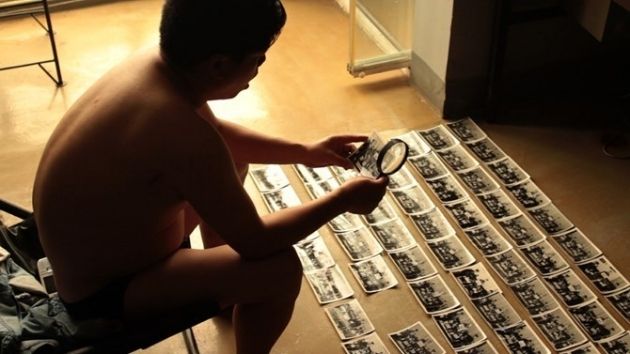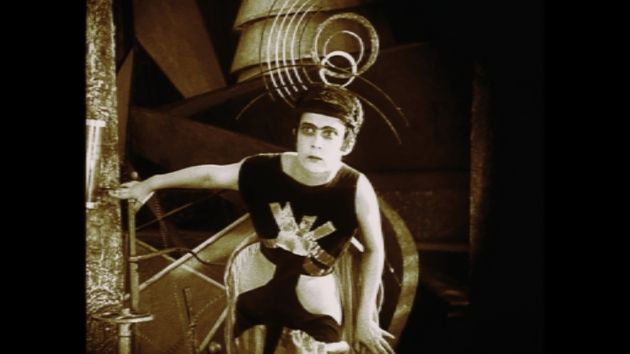*Originally published on 10/2/2015 at NYFF. ARABIAN NIGHTS VOLUME 1 Opens Dec. 4, VOLUME 2 Opens Dec. 11, VOLUME 3 Opens Dec. 18 at the Film Society of Lincoln Center

It was 3 years ago I first met Miguel Gomes in a cramped office of New York's Film Forum. His third feature Tabu was a big international success and I was just discovering his fantastic films. But it was the state of Portugal under stringent austerity measure that dominated our conversation, not as much the film itself. At that time, Portuguese government was about to announce a new law concerning how the small but vibrant Portuguese film community would get funding, which had completely stopped because of the country's financial crisis (and greed of corporations, you can read it
here). As a film lover, it was one of the most invigorating, memorable interviews I've conducted.
Gomes's new film (or should I say films), Arabian Nights Vol.1, 2 & 3, has been my most anticipated film of the year. And I was more than eager to continue our conversation. And I was pleasantly surprised that the director remembered me from the last time.
So, the last time, we were talking about the Portuguese film industry under the country's austerity measure and the government delaying the announcement of the new law concerning the funding. Can we pick up where we left off?
Miguel Gomes: Yeah, we are talking about the year (2012) when the funding was completely stopped. It was the year zero for Portuguese cinema. There wasn't any support like the way we used to have from the Institute of Cinema. From then on, the new law was enacted. But we were more than a little bit disappointed because they said the support would be a lot bigger than what we normally had. I can still remember when I first started to make films, there were about 20 feature films made every year. Nowadays I would say, about 8. Yes, it's better than zero. That was what we had in 2012. But it's very hard for filmmakers because there is no other means to make films in Portugal. The market itself is so small there is no money to be made, hence no corporate sponsors. It's economically...it's almost impossible. But I have to say that at least there are films being made. It continues. They now say they will raise the numbers (of films produced per year). We just have to wait and see.
That's the Portuguese cinema side. What's going on in general in Portugal?
I think it's much more difficult when compare specifically to cinema. The whole society was of course deeply affected by the changes that occurred in the last few years. The country was under the program where we borrowed money to help lower the national debt. But in my opinion, what happened was that the debt didn't go down, it continued to be the same. So for me, it means something failed.
On the contrary, the incomes of general Portuguese population and state welfare were very much affected. The pensions of retirees were cut 30-40 percent, the salaries of public workers were also severely cut and support for the unemployed were also very restricted. In general, the whole Portuguese society is much poorer than 7 years ago.
To be honest, even though there are some signs of economic recovery, it was not because of these programs but because we really hit rock bottom, there was no way but to go up a little bit. Now they are trying to paint a picture that Greece is a bad student and we are a good student. For me it's a bad fiction. This fiction is pretending that it's the reality that people have to go with. This is one of the reasons I made this film because I thought, "Let's fight bad fiction with fiction."
That said, ARABIAN NIGHTS is in 3 parts, 6 hours. It's big and sprawling. How did you come to the decision that you will make something this big?
I would say it was like an accident. I received lots of support because Tabu was very successful. It was released in dozens of countries. So I got more money than I had making all my previous 3 films combined. This is why I think I ended up with three films. But we did know that when we started it, it would be in three volumes. We had more time to shoot than we normally would have, so I spent all my money to shoot more and more stories. But we didn't know how big a stretch of a film it would be. Of course we were worried, we weren't so naïve that we could prolong the shoot indefinitely. But during the shoot, we didn't want to think about it.
Then we had some options. We could have made certain sections of the film completely cut out or to make a very very big film. Then we went back to having three volumes. I had my Portuguese translation of Arabian Nights in three volumes with me. I showed them to my producers that it is possible that the film could be divided in to three and three very different experiences of cinema.
Each part of the film is something I've done before. In Tabu, I organized the structure in two parts. So this would be in three parts and they will be in communication with each other, like Tabu. In each part, there will be stories connecting to each other or opposite of each other, so when you see the film, this would give that narrative labyrinth--
Just like the book.
Exactly. For me the book is like a vertical labyrinth that has great potential for film adaptation which is much richer than my film, I mean, they have more space... (chuckles)
Were there any stories that you had to cut out?
No, in the end, we used every segment we shot. We cut lots of sequences in each chapter. What we cut was ideas - we had many more stories in mind but couldn't afford to shoot. The drama of the shoot was in what we decided to shoot and we had 20 possible ideas that were even better than what we shot. But we had to choose what ideas to shoot.
I liked your use of non-professional actors in fictional settings. Like...
Chico Chapas.
Chico Chapas exactly.
In his case, I already filmed him as himself in the last segment of in Volume Three about the bird trappers (in chapter: The Inebriated Chorus of Chaffinches). We have a very artificial elements in the film because it's not reality but cinema. Cinema talks about life but it's not real life. I myself am much closer to Wizard of Oz than realism. So we already had some professional actors who were playing more than one role. And I saw this guy (Chapas) catching birds in the woods in the countryside of Portugal, then we had this story of criminal running away in the countryside (Chapter of A Man Without Bowels). I didn't have an actor in mind for that role. But I also didn't have anyone who can walk with same elegance as Chico Chapas.
The part didn't have many lines. I couldn't ask him to play the judge because it was played by a very good theater actress Joana de Verona. So for each chapter of the film I had people playing with their specific skills. For Simão in Man Without Bowels, I needed someone who has John Wayne like aura. Chico carries himself like John Wayne. I never told him how to walk or anything. I called action and told him walk from left to right and nothing else and it was always the first take we used. He was a natural.
The owner of the cockerel (Fernanda Loureiro) in chapter: The Story of the Cockerel, for instance, she was also playing herself. She really is the owner of the real cockerel who ended up in court. But the cockerel we had to have a double because it got very famous after the court case and we didn't want anything happen to it. But Fernanda was the real owner. So we found out while talking to her on camera, what she will tolerate, what she can and can't do. We found out that there are certain people who can direct themselves in certain way.
In the Swim of the Magnificents chapter, we had these unemployed people telling their stories. We had to work with them a little bit. I was with them all throughout and asked them every 2 days or so to tell me their stories. It was like directing them to tell certain part of their stories differently just for the better structure, not the content. It was about letting them talk. I wasn't going to write a script for them to recite like robots. That's not what I intended to do.
Every time it was different, even with professionals. Because you are always dealing with different people. But in the end, it's about them. For me it's finding out what you can do to help them bring out the best that they can give you.
I want to hear about how you got together with Sayombhu Mukdeeprom.
In this case, in the beginning I wanted to work with my regular cinematographer (Rui Poças) who shot My Beloved Month of August and Tabu, but he wasn't available. And it was such a rigorous shoot. We shot for a year. But someone in the crew who worked in Italy with Sayombhu, the cinematographer of Apichatpong (Weerasethakul) and she said, "He is a nice guy and I think you two will get along." But I said, "But I don't think he will be crazy enough to come to Lisbon from Thailand for a year. And I have to tell him that we don't know what we are shooting because there is no script. There is nothing." But I phoned him and he said, "OK, let me talk with my family" and one week later, he said, "I'm coming." I was like, you are crazier than I, RESPECT!
So he came and it was very good working with him. He is very good at shooting only with natural lights. One great thing we shared was our love for shooting on film. He gets frustrated if someone asks to shoot on digital. So it was one of the reasons why he traveled so far. It appealed greatly to him for a fact that he can shoot on film for a year. We shot on 16mm and 35mm.
It as very easy to work with him. We didn't discuss anything before starting the film - no look of over all film or anything. It was very natural process. It was always during the shoot we discussed how to go about shooting that scene. Except the Tears of the Judge part - with three moons with three different colors which we did some preparation. We got along fine because we have the same spirit of not calculating everything beforehand.
Would you ever work with him again?
Yes of course. But I'd love to continue working with Rui too. I'd love to work with both.
I saw the new Apichatpong's film yesterday (Cemetery of Splendour), very sweet, very moving film too but he had to use another cinematographer for that because of me. (laughs)
How do you feel about VOLUME 2: THE DESOLATE ONE getting chosen for the official Portuguese entry for Oscar Foreign Language Film?
I had nothing to do with that selection. It was Portuguese Academy who decided that. I think there is some rule that a film should end with a credit. So there is no way the whole Arabian Nights will get nominated as one film.
Ah, the technicality!
I'm not expecting anything. But strange things happen. We will see.





































